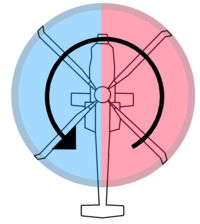Dissymmetry of lift

Okay kiddo, let me explain what dissymmetry of lift is. When an object like an airplane flies through the air, it creates lift, which is an upward force that keeps it from falling. But did you know that this lift can be different on different parts of the airplane's wings?
That's what dissymmetry of lift means. Imagine you have two identical paper airplanes, and you throw them both at the same time but in opposite directions. One will fly to the left, and one will fly to the right. That's because the way the air is moving over the wings is not the same for both airplanes.
The same thing can happen with real airplanes. The wings on each side of the plane can be facing different angles, or they can have different speeds of air flowing over them. This creates a difference in lift, and it can cause the airplane to tilt or roll to one side.
To prevent this from happening, planes have ailerons. These are small flaps on the back of the wings that can be adjusted to change the lift on each side of the plane. When the pilot moves the ailerons, they can make the plane go up, down, left, or right.
So, in short, dissymmetry of lift means that lift can be different on different parts of an airplane's wings, and this can cause the plane to tilt or roll to one side. But with ailerons, the pilot can control the lift and keep the plane flying straight and level.
That's what dissymmetry of lift means. Imagine you have two identical paper airplanes, and you throw them both at the same time but in opposite directions. One will fly to the left, and one will fly to the right. That's because the way the air is moving over the wings is not the same for both airplanes.
The same thing can happen with real airplanes. The wings on each side of the plane can be facing different angles, or they can have different speeds of air flowing over them. This creates a difference in lift, and it can cause the airplane to tilt or roll to one side.
To prevent this from happening, planes have ailerons. These are small flaps on the back of the wings that can be adjusted to change the lift on each side of the plane. When the pilot moves the ailerons, they can make the plane go up, down, left, or right.
So, in short, dissymmetry of lift means that lift can be different on different parts of an airplane's wings, and this can cause the plane to tilt or roll to one side. But with ailerons, the pilot can control the lift and keep the plane flying straight and level.
Related topics others have asked about:
